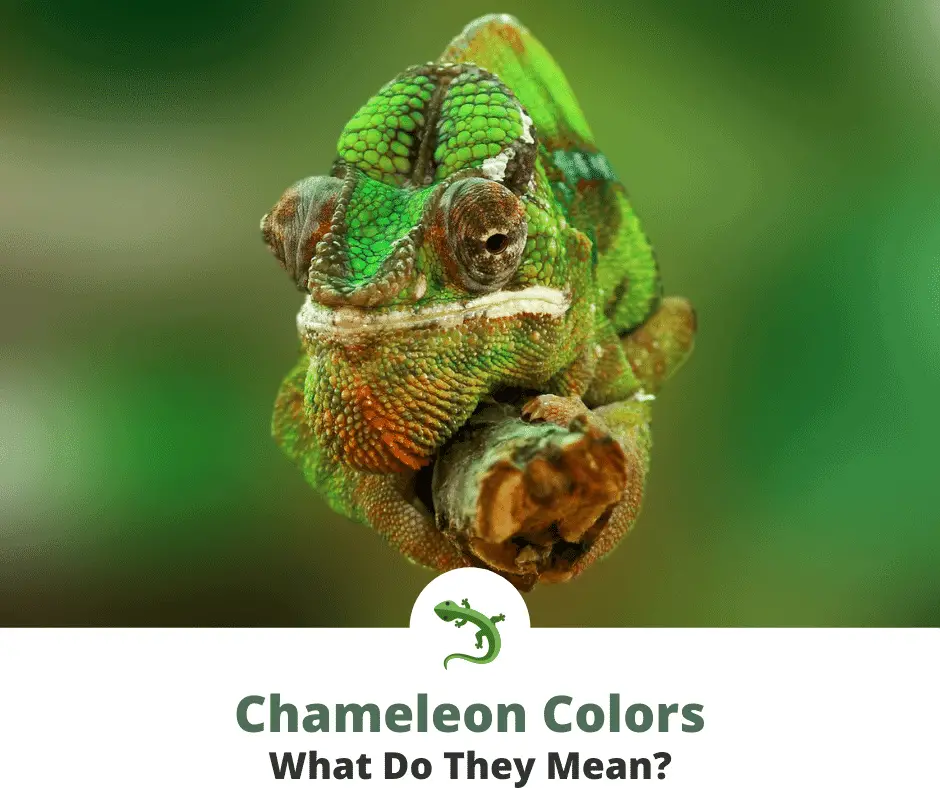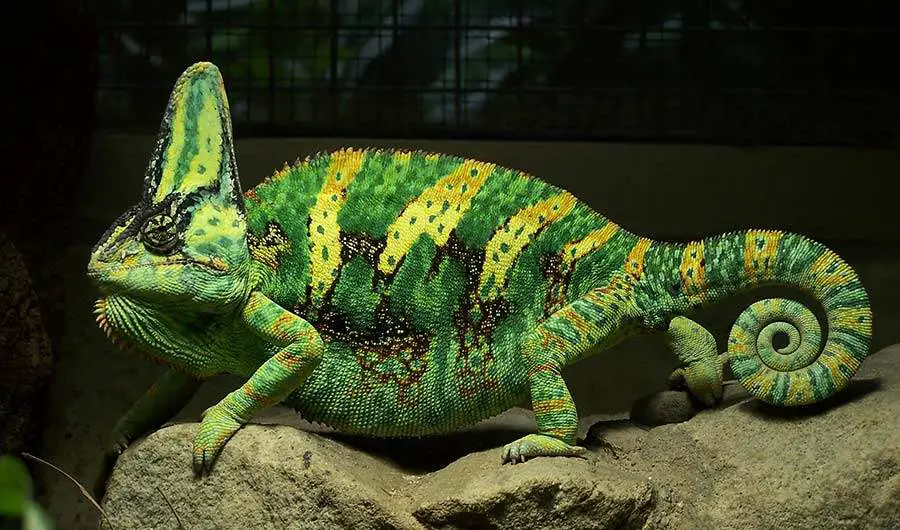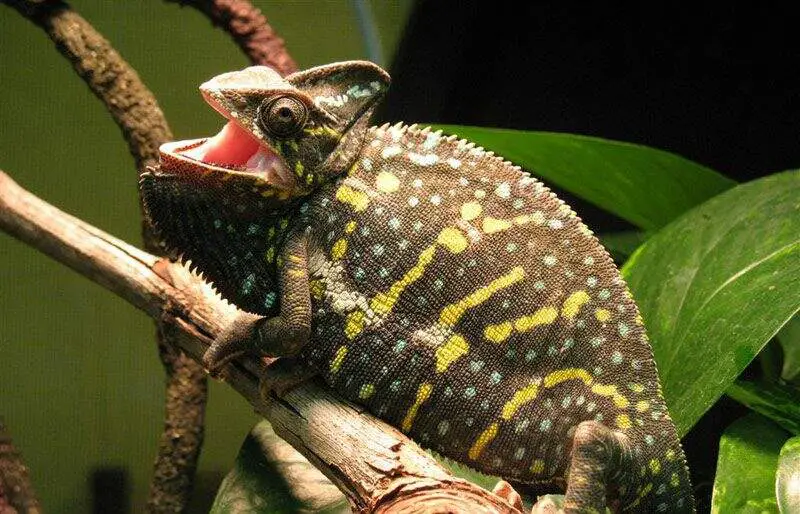This guide will teach you what a Chameleon’s color means and the science behind how they’re able to change colors.
You’ll learn:
- What do colors communicate about their mood?
- How does their environment affect their color?
- How do Chameleons actually change color?

A Chameleon’s color can be affected by temperature, it’s also a good indicator of its mood, and is used as a means of communication.
Chameleons are a distinct group of lizards that are found in the mainland of sub-Saharan Africa and on the island of Madagascar. There are a few species that live in northern Africa, southern Europe, the Middle East, southern India, Sri Lanka, and smaller islands in the western Indian Ocean.
They are best known for their ability to change their skin color which is a defense mechanism that allows it to hide in the wild. With good reason, as these reptiles are almost defenseless – their bite is not dangerous, they have no poison, and they’re not too quick on their feet. Blending into their surroundings is pretty much the only way they can avoid predators. Keep in mind that they do not really copy their background as some YouTube videos will show, but they will blend with natural colors such as greens and browns of foliage to camouflage themselves.
📚 Read More >> Types Of Chameleons

What Do Chameleon Colors Mean?
Vivid colors in nature are often signs of an animal’s mood, defense mechanism, or indication of mating. Red, yellow, and black striped coral snakes are widely known to be venomous and peacocks often display their bright colored tails to attract a mate. Chameleons are no different – their skin colors can have different meanings.
Aside from reflecting how they feel like mood rings from the 90’s, a chameleon’s color can also change in response to temperature. They turn darker when they feel cold to allow their skin to absorb more heat (like how you feel stuffy wearing a dark shirt out in the sun).
In general, darker colors indicate stress and brighter colors like green, red, and orange indicate excitement or aggression. Muted or neutral colors show a relaxed state. Knowing what chameleon colors mean can help you gauge their mood or even check if they feel sick.
📚 Read More >> How To Fix Cloudy Turtle Tank
Normal Coloration
When resting or in its neutral state, most chameleon species are green or brown. The color does differ between species and usually depends on their natural habitat to help it blend into its environment when needed. For example, the more colorful Panther chameleon (Furcifer pardalis) originated from the tropical rain forests of Madagascar while Pygmy or dwarf chameleons, which mostly live on forest floors in the wild, have more subdued brown colors to match dead foliage. Their natural resting color will also dictate the color their skin can change into (e.g. only Panther chameleons can turn bright red). The color-mood guide below is most applicable to more common species of chameleon kept as pets such as the Veiled chameleon (Chamaeleo calyptratus).
Showing Aggression
Chameleons will show aggression using bright colors, especially when defending their territory against another male. They show explosive and quick changes in color – red or bright green, blue, or yellow and even white. In the wild, this is used to make themselves more visible against their backdrop like a tree to protect their territory or warn their opponent. Weaker males will dim or mute their colors first to show defeat. They are also aggressive during the mating season and will show bright colors to attract a female.

📷 by B kimmel via Wikimedia Commons
Mood Expression
Darker colors usually indicate stress in chameleons and brighter colors like green, red, and blue indicate excitement. Black colors especially on their throats will show up when they are threatened or feel ill. Neutral colors indicate a relaxed state. Angry chameleons often change into red with a black stripe while males ready to mate look like they’re dressing up with bright colors to try and impress a girl. Brown colors can also indicate depression in chameleons or a sign of brumation. Neutral colors in females indicate when she is not in the mood – they turn brown or white if they are already gravid (carrying eggs). A sick chameleon will also be dark colored, almost black. Some are pale especially at night.
Relaxed or Subdued
Colors that mimic natural backgrounds such as brown or green indicate a chameleon in a relaxed state. They are known to move into an area in their environment that matches their relaxed color best for maximum camouflage, making them feel safer or helping them hide if they feel subdued. Veiled chameleons display this state best in their neutral brown colors when relaxed.
Fear
Chameleons are often stressed under fear so they will flash darker colors when attacked or in shock. This is probably to help them blend into their surroundings better in the wild under threat. Chameleons will stay in this darker color until they feel safe and may even roll into a small ball shape for more protection.

📷 by Eric Adrignola
Research has shown that in the wild, male chameleons will dull or mute their color to impersonate a female allowing them to sneak past another male without picking a fight. Females also show muted colors to indicate submission or avoid males as males tend to be aggressive especially during the mating season.
Indication of Mating Time
Males use vibrant colors to signal their desire to mate, trying to dazzle and attract females during courtship. Red hues in a chameleon’s skin, especially around its head and sides, will often brighten up during this stage of stimulation. Others are red with black, blue, white, or yellow stripes.
Females will display a warning color when they do not want to mate or are already gravid with a brown or white stripe along their body.
Changes in Environment (Temperature, Humidity, etc.)
Since chameleons are ectotherms (cold-blooded) and depend on their environment to regulate their body temperature, they can turn a darker color to maximize absorption of heat from the sun/basking lamp (darker colors absorb more light). Conversely, they tend to have lighter skin on hotter days since bright colors such as light blue or green reflect more light.
Though poorly researched, it is believed that changing skin color to help regulate their body temperature is a trait that seems to be widespread among reptiles, even Bearded Dragons!
Communication With Other Chameleons
Female chameleons often use color to indicate their readiness to mate. She is light or pale green if she wants to mate and will turn dark and aggressive if she already has the sperm of another male. As mentioned above, a male’s bright color communicates dominance and aggression over others as well as a sign that he is courting a female.
Excitement and Stimulation
Chameleons are also known to change color when excited or stimulated such as when hunting their prey or mating. Veiled chameleons will turn dark green, yellow, or brown when they become excited to hunt. A panther chameleon is often black, dull brown, or dark red when it feels attacked.
How Do Chameleons Change Colors?
Well, mostly physics and maybe just a little bit of magic and mirrors. It was often believed that the color change in a chameleon’s skin cells had something to do mainly with pigmentation, but scientists in 2015 found that they also do this by adjusting special cells in their skin that contain very small crystals (nanocrystals) that reflect light.
These colorful lizards can “tune” the spacing between nanoscale crystals in special cells of their skin called “iridophores” (from the Latin word “iris/irid” meaning rainbow and “phores” meaning “to bear”) affecting how these nanocrystals reflect light. These special cells are sometimes called chromatophores.
Before we explain further, let’s have a quick review on how we perceive the color of the things we see. The color of an object corresponds to the wavelength of light it reflects. Reds and yellows have longer wavelengths while blues and violets have shorter wavelengths. If the object reflects the longer wavelengths of light, we see it as yellow or red and vice versa.
Think of the nanocrystals in the iridophores of a chameleon’s skin as “mirrors” whose size the chameleon can adjust based on how it feels. The nanocrystals are spaced far apart (the “mirrors” are “longer”) when the chameleon is stressed allowing it to reflect brighter colors with longer wavelengths such as yellow and red. When the chameleon is relaxed, these nanocrystals are closer together (the “mirrors” are shorter) allowing colors with shorter wavelengths to be reflected, so we see more relaxed colors such as blue and green.
A dark pigment in the chameleon’s skin called melanin is involved in the color change associated with a submissive mood (to show that it is not a threat) but instead of using the nanocrystals, the chameleon does this by dispersing melanin into its upper skin layers. In the wild, when it’s cold and the sun is out, chameleons also increase the melanin in their upper skin layers to darken up and warm up faster.
The interplay between the special mirror like crystals and the natural pigmentation of the chameleon’s skin gives it its wide range of colors and hues (e.g. natural yellow pigmentation + blue reflected light = green color we often see in chameleons).
Do all chameleons change colors?
All chameleons have the ability to change colors but some species can change color faster than most (in less than 20 seconds) and others have a wider range of hues and colors. Veiled, Panther, and Madagascar chameleons can change color quickly in bright hues of green, yellow, and blue. Others can only change between light and dark colors such as chameleons known to be tree dwellers which are usually just green, blue, or black. Those from arid areas and deserts don’t change their color too much and are naturally lighter since they live in hotter environments.
Adult males tend to change color more often especially when they are aggressive towards another male or want to attract a female. Younger chameleons and females are lighter colored or even dull and have less iridophores in their skin with the exception of Carpet chameleons whose females are more ornate than males. Panther and Madagascar chameleons are known to be extremely colorful and are the most photographed kinds. Incidentally, these species are also the most territorial – go figure.
How do you calm a chameleon down?
To calm a chameleon down, help it feel safe by turning the cage lights off, covering the cage, and leaving it alone. The cooler and darker environment will help calm it down and make it less reactive. Your safest bet is to leave it alone especially when your chameleon hisses, indicating stress from a change in its environment or from being handled. Make sure your chameleon’s environment is in good shape to keep it calm (e.g. the correct temperature and humidity). Also, check if there’s anything that caused it to feel threatened – perhaps it saw its reflection, and observe if your chameleon is sick or injured.
Conclusion
A chameleon’s ability to change its skin color is often a reflection of how it reacts to its surroundings. If another male is present, it’ll look aggressive with bright colors but if there is a bigger threat such as a predator, it will become muted or subdued to help it hide. Temperature can also affect its color and their color can also be used to communicate with others.
Further Reading
Informative articles that explain how chameleons change color and why:
The Secret to Chameleons’ Ability to Change Color
Chameleons’ Craziest Color Changes Aren’t for Camouflage
Great article with good visuals that explain how chameleons change their skin color:
Chameleon Colors Reflect Their Emotions
Short forum answer that explains a chameleon’s mood with pictures:
What do a chameleon’s colors mean?
The full scientific study on how a chameleon changes its color:
Photonic crystals cause active colour change in chameleons


